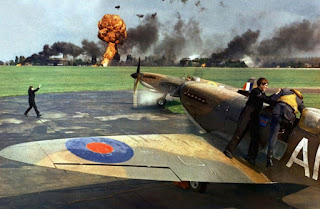Director Guy Hamilton - 1969 poster
In the Chicago Tribune, Gene Siskel wrote: The film is a 12-thousand-megadollar bomb that features 100 vintage planes eating up 40 minutes of film. The film has absolutely no dramatic interest in the other 93 minutes... Well, I enjoyed it. I assume his problem was there wasn't a single American in it; MGM couldn't falsify History that much (although the Enigma story seems to have done it). No John Wayne, or James Coburn, no Lee Marvin or Steve McQueen on his stupid, and entirely fictitious, motor-cycle exploit. I would agree with another critic, Roger Ebert, that the aerial scenes...repeat themselves shamelessly, until we're sure we saw the same Heinkel dive into the sea... Even I noticed the re-use of footage BUT the Battle of Britain was about aerial combat. In 633 Squadron, Cliff Robertson, an American, played a part written originally about a British hero. But that's okay. As long as Uncle Sam is centre stage, everything is hunky-dory.
I thought the scene featuring Ralph Richardson, as the British Ambassador to Switzerland, having to listen to Curt Jurgens ranting on about Goering would like to flatten London, merely responding It's two lumps you take, isn't it Minister? was brilliant. Another good response was Laurence Olivier's (Air Chief Marshal Sir Hugh Dowding), when asked by the Minister, So, I tell the Cabinet that you're trusting in radar and praying to God?, saying, More accurately the other way around. We're trusting in God and praying for radar. Another amusing, if semi-tragic cameo, was the man struggling into the Community shelter, moaning They got the Rose & Crown, twice. Another, female, voice saying He'll have to drink at the Red Lion - if they'll 'ave 'im.
Laurence Olivier as Dowding : Susannah York as Maggie Harvey
With such a stellar cast, it was often a case of 'place the face'. Delicious Susannah York was easy; as was Christopher Plummer. Watching Kenneth More as a Group Captain and Edward Fox as a Pilot Officer, only confirmed to me that they rarely 'acted', just played themselves whenever on the screen, whatever the subject or part. Kenneth More was easily the worst Richard Hannay in one of the movie versions of The 39 Steps. It was interesting to see a young Ian McShane with an unlined-face; to listen to Alvar Lidell on the radio and hear Michael Caine wrestling inadequately with a 'posh' accent; and spot old stalwarts like Harry Andrews, Trevor Howard and Patrick Wymark (who, alas, died the following year). No room for Richard Todd, John Mills or Jack Hawkins, though!
I thought the Luftwaffe bombings of the airfields was realistic; as were the various scenes in the command centres; the German side's build-up and arguments; and the poignant scene when Ian McShane realises he has lost his wife and children to a Nazi raid. It was good to see Christopher Plummer driving an MG TA Midget (or was it an MG TB?), as I recall fondly my own MG TC model. The aerial shots of London being bombed, particular when the backcloth was Tower Bridge, was below the standard of the rest of the film.
The movie premiered at the Dominion Theatre in London on 15th September 1969 (attended by 350 Battle of Britain veterans, including Air Chief Marshal Dowding) and was the number one film in the UK for a total of fourteen weeks that year; but, due to the large cost of production, it lost $10 million. Unfortunately, the film was released when there was an anti-war feeling stirred up by the Vietnam War. There was also cynicism amongst post-war generations about the heroism of the 'few'. Trust the 1960s - for my mind (apart from the periods of the two World Wars) the worst decade of the twentieth century.
2011 DVD





No comments:
Post a Comment